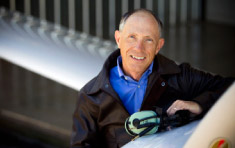 Early this fall an Air Safety Institute (ASI) team flew to Chester, Connecticut, to conduct a safety program after a Turbo Commander accident in New Haven. The TC-690 was on a circling instrument approach when it departed controlled flight in, or near, the base-to-final turn. The Commander crashed into a house; two children, as well as the pilot and his son, were lost.
Early this fall an Air Safety Institute (ASI) team flew to Chester, Connecticut, to conduct a safety program after a Turbo Commander accident in New Haven. The TC-690 was on a circling instrument approach when it departed controlled flight in, or near, the base-to-final turn. The Commander crashed into a house; two children, as well as the pilot and his son, were lost.
Ground fatalities are rare but almost always attract media attention. Over the past five years, the national average was three people lost to aircraft falling on them. That doesn’t diminish the individual tragedy, but it does put the risk into context. Pedestrian fatalities exceeded 4,400 last year and lightning deaths average just more than 50 annually. AOPA’s Communications Division and ASI strive hard to convey a realistic perception immediately after an accident and in the weeks that follow. Safety seminars provide one opportunity to educate both the media and the community. However, several weeks after an accident, the media focus often is on other events.
Speculation is often rampant early in investigations, and inconvenient facts can drastically change the perception of an incident. A few years ago an LSA was lost during a student orientation ride. An aviation pundit—who should have known better—ventured an opinion regarding the general inferiority of LSAs and posited a design or mechanical fault. Contrary to that assertion, a screwdriver lodged in the elevator control system after the aircraft was airborne rendered it uncontrollable. So much for instant analysis.
Occasionally pilots behaving badly create a public relations debacle. In one particularly egregious case a couple of guys actually said before takeoff they would show the world how flying was done. The low-level aerobatic display over a neighborhood was a spectacular display of incompetence and poor judgment. There was predictable outrage when they stalled over a house, killing themselves and a sleeping teenager. In ASI’s seminar that followed, we avoided the specifics of the crash but made it very clear what both regulations and common sense require.
The flight from Frederick to Connecticut took place on a beautiful VFR afternoon, directly over the top of the New York Class Bravo airspace. We used flight following, onboard traffic avoidance, and even managed to look out the window to avoid any slightly close encounters. Only in the United States could this have been done, and the controllers do a fabulous job of managing this in the busiest airspace in the world. Our altitude was optimal for keeping the flight above arrivals and departures and well below en route airline aircraft.
We passed directly over the Newark and La Guardia airports; the Hudson River corridor; and viewed the Manhattan skyline, the Statue of Liberty, and the new One World Trade Center from 9,500 feet. Only in America! It is both impressive and sobering to look at the expanse of buildings below. There aren’t many places for a forced landing—although I’ve heard the Hudson River will do in a pinch.
Chester is about 20 miles inland and nestled in a large forested area. No zoning problems here—unlike New Haven, which has typical encroachment. The airport is privately owned, but open to the public. It belongs to Whelen Engineering. A police officer with flashing blue and red lights—Whelen. Red and white lights on fire trucks and ambulances—Whelen. Pace car lighting as well as the green, yellow, and red control lights at a NASCAR race—Whelen. And chances are pretty good that your aircraft strobes or anticollision lights are Whelen as well. The company hosted the program and provided refreshments for the 90 or so pilots who made the trek out to hear our safety message. Some had driven well more than an hour. For us, the airlines would have taken longer than the hour and a half each way but they can’t always go door to door. It also would have required the time and expense of an overnight stay.
It is the nature of news pundits, bloggers, and this column to focus on the negative, but for the vast majority of pilots on the vast majority of flights, it all works as intended. The unreachables won’t participate but the teachables far outnumber them.
Once the program was over and all the questions answered, we flew back down the Northeast Corridor marveling at the sea of lights, the night, and our freedom to fly in these United States. That’s worth defending!


